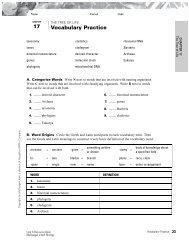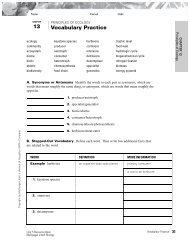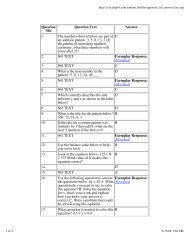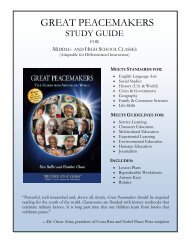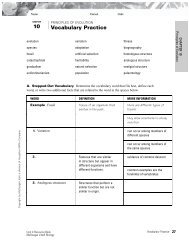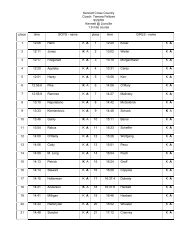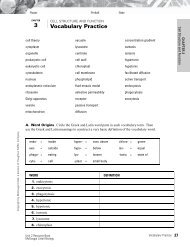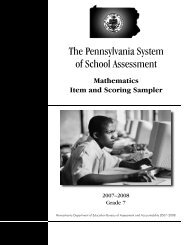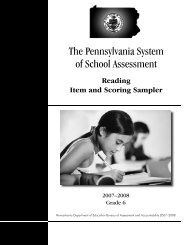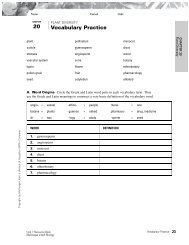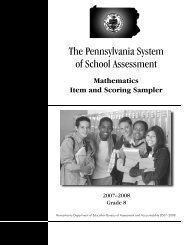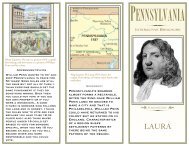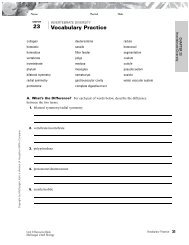6 Vocabulary Practice - KCSD Staff Pages
6 Vocabulary Practice - KCSD Staff Pages
6 Vocabulary Practice - KCSD Staff Pages
- No tags were found...
You also want an ePaper? Increase the reach of your titles
YUMPU automatically turns print PDFs into web optimized ePapers that Google loves.
VOCABULARY PRACTICE, CONTINUEDB. Words in Context Answer the questions to show your understanding of thevocabulary words.1. Which is like a karyotype, a satellite weather map, or the temperature on one streetcorner?2. Is incomplete dominance like a glass of cranberry-raspberry juice or a pizza witheverything?CHAPTER 7Extending Mendelian Genetics3. Is X chromosome inactivation like an electrical generator or a power failure?4. Would a pedigree be used to trace genes in a family or to send a dog to obedience school?5. Is codominance like doing your homework or two people talking at the same time?6. Which is like a carrier, a ferry crossing a lake, or a door opening?7. Are exact directions or a general idea of where you are going more like a linkage map?8. Is a polygenic trait more like a basketball team or a figure skater?C. Do-It Yourself Matching In a random order, write short definitions for each term onthe blank lines to the right. Then give your paper to a classmate who should write the numberof the term next to the correct definition.1.sex-linked gene2.incomplete dominance3.carrier4.linkage map5.codominance6.karyotypeCopyright by McDougal Littell, a division of Houghton Mifflin Company58 <strong>Vocabulary</strong> <strong>Practice</strong> Unit 3 Resource BookMcDougal Littell Biology
VOCABULARY PRACTICE, CONTINUEDD. Who Am I? Choose among these terms to answer the riddles below:carrier karyotype polygenic traitcodominance linkage map X chromosome inactivationincomplete dominancepedigree1. I am the process that randomly turns off one X chromosome in a humanfemale’s cells.2. I am an interaction between two alleles in which both alleles are fully andseparately expressed.3. I am a chart that can be used to trace genes through a family.4. I am a picture that shows the overall structure of chromosomes.5. I am an interaction between two alleles that produces a phenotype that isbetween the phenotypes of homozygotes.6. I am a person who does not show a genetic disorder, but I can pass it on tomy offspring.CHAPTER 7Extending Mendelian GeneticsCopyright by McDougal Littell, a division of Houghton Mifflin Company7. I am a map of genes on a chromosome, but I do not show the exact locationsof the genes.8. I am a trait that is the result of many genes.E. Find the Odd Word Put a checkmark next to the word that does not belong.1. karyotypelinkage mapX chromosomeinactivation2. sex-linked genepolygenic traitcarrierExplanationExplanationUnit 3 Resource Book <strong>Vocabulary</strong> <strong>Practice</strong> 59McDougal Littell Biology
VOCABULARY PRACTICE, CONTINUED3. linkage mapincomplete dominanceExplanationcodominance4. incomplete dominancekaryotypeExplanationpedigreeCHAPTER 7Extending Mendelian GeneticsF. Analogies Read each analogy. Decide which term is most like it.carrier codominance linkage mapX chromosome inactivation polygenic trait karyotypeincomplete dominance1. Airport baggage handler2. Blending the ingredients of a fruit smoothie3. Randomly flipping switches in an electrical panel4. A still-life painting5. All of the people who make up the United States6. Mixing the ingredients of a fruit salad7. A train schedule that shows the stops made by the trainWrite your own analogies to show the meaning of these terms:8. sex-linked gene9. pedigreeCopyright by McDougal Littell, a division of Houghton Mifflin Company60 <strong>Vocabulary</strong> <strong>Practice</strong> Unit 3 Resource BookMcDougal Littell Biology
CHAPTER8FROM DNA TO PROTEINS<strong>Vocabulary</strong> <strong>Practice</strong>bacteriophage RNA polymerase promoternucleotide messenger RNA (mRNA) operondouble helix ribosomal RNA (rRNA) exonbase pairing rules transfer RNA (tRNA) intronreplication translation mutationDNA polymerase codon point mutationcentral dogma stop codon frameshift mutationRNA start codon mutagentranscriptionanticodonA. Compound Word Puzzle Read the phrase and write the word that it most closelydescribes. Then write another phrase that describes the same word in a different way.PHRASE 1 WORD PHRASE 2Copyright by McDougal Littell, a division of Houghton Mifflin Companyerror that throws off the readingframe of an mRNA sequenceexplains Chargaff’s rules 1.states that genetic informationflows in one directionpairs with an mRNA codonduring translationExampleframeshift mutation2.3.an intervening sequence 4.caused by insertion or deletionof nucleotidesCHAPTER 8From DNA to Proteinsthe type of RNA that isconverted to a protein duringtranslation5.Unit 3 Resource Book <strong>Vocabulary</strong> <strong>Practice</strong> 95McDougal Littell Biology
VOCABULARY PRACTICE, CONTINUEDPHRASE 1 WORD PHRASE 2a change in an organism’s DNA 6.monomer that makes up nucleicacids7.a sequence of mRNA that isexpressed after processing8.B. Find the Odd Word Put a checkmark next to the word that does not belong.1. mutagenrRNAExplanationtRNACHAPTER 8From DNA to Proteins2. codonmRNAreplication3. central dogmamutagenmutation4. codondouble helixframeshift mutation4. bacteriophageRNA polymerasetranscriptionExplanationExplanationExplanationExplanationCopyright by McDougal Littell, a division of Houghton Mifflin Company96 <strong>Vocabulary</strong> <strong>Practice</strong> Unit 3 Resource BookMcDougal Littell Biology
VOCABULARY PRACTICE, CONTINUEDC. Secret Message Next to each definition, fill in the blanks with the vocabulary wordthat best fits each description. When complete, write the boxed letters in order in the blanksat the bottom of the page to answer the clue.1. large enzyme that initiates transcription2. caused by the insertion or deletion ofnucleotides in DNA3. spliced together during mRNA processing4. part of a ribosome; catalyzes the formationof peptide bonds between amino acids5. a change in a single nucleotide in DNACopyright by McDougal Littell, a division of Houghton Mifflin Company6. examples include radiation and UV light7. made up of a sugar, a phosphate group, anda nitrogen-containing base8. the part of the central dogma that occurs inthe cytoplasm of eukaryotic cells9. Fill in the blanks with the boxed lettersfrom above to name a region of DNAwhere RNA polymerase binds:CHAPTER 8From DNA to ProteinsUnit 3 Resource Book <strong>Vocabulary</strong> <strong>Practice</strong> 97McDougal Littell Biology
VOCABULARY PRACTICE, CONTINUEDD. DNA Adventure! Solve the clues by filling in the words in the numbered squares.Across2. the process that makes a polypeptide4. A, C, G, and T in DNA; A, C, G, and U inRNA5. component of ribosomes12. process that involves RNA polymerase15. sequence in mRNA that is not expressed asprotein16. three-dimensional model developed by Watsonand Crick17. the rules that explain how nucleotides interactwith each otherDown1. a change in a single nucleotide in DNA3. the process of making a copy of DNA6. complementary to an mRNA codon7. carries an amino acid from the cytoplasm to aribosome8. major enzyme involved in replication9. describes the flow of genetic information10. used by Hershey and Chase in theirexperiments11. may be induced by mutagens13. halts translation14. helps RNA polymerase recognize the start of agene1.2.3.4.5.CHAPTER 8From DNA to Proteins17.8.9.14.13.16.12.10.6. 7.15.11.Copyright by McDougal Littell, a division of Houghton Mifflin Company98 <strong>Vocabulary</strong> <strong>Practice</strong> Unit 3 Resource BookMcDougal Littell Biology
CHAPTER9FRONTIERS OF BIOTECHNOLOGY<strong>Vocabulary</strong> <strong>Practice</strong>restriction enzyme genetic engineering Human Genome Projectgel electrophoresis recombinant DNA bioinformaticsrestriction map plasmid DNA microarraypolymerase chain reaction (PCR) transgenic proteomicsprimer gene knockout genetic screeningDNA fingerprint genomics gene therapyclonegene sequencingA. Stepped-Out <strong>Vocabulary</strong> Define each word. Then write two additional factsthat are related to the word.WORD DEFINITION MORE INFORMATIONExample plasmidclosed loop of DNA separatefrom bacterial chromosomecan replicate on its ownused for making recombinant DNACopyright by McDougal Littell, a division of Houghton Mifflin Company1. clone2. genomics3. genetic screening4. DNA microarray5. proteomicsCHAPTER 9Frontiers of BiotechnologyUnit 3 Resource Book <strong>Vocabulary</strong> <strong>Practice</strong> 129McDougal Littell Biology
VOCABULARY PRACTICE, CONTINUEDB. Situational <strong>Vocabulary</strong> Circle the letter of the situation that most closely relatesto each vocabulary word.1. gene therapy: a) buying a bicycle; b) replacing a flat bicycle tire2. gene sequencing: a) reading a book’s table of contents; b) summarizing a book in areport3. gel electrophoresis: a) counting out 100 pennies; b) sorting coins by value4. polymerase chain reaction: a) division; b) multiplication5. clone: a) a photocopy; b) a fragrance for men6. DNA fingerprint: a) a group yearbook picture; b) a driver’s license picture7. primer: a) a referee’s whistle to start a game; b) the horn at the end of a game8. bioinformatics: a) searching the index of your biology textbook; b) reading yourbiology textbook from beginning to endC. Analogy <strong>Vocabulary</strong> Set On one blank line next to each vocabulary word, write theletter and number of the definition that best matches. On the other blank line, write the letterand number of the analogy that best matches.CHAPTER 9Frontiers of BiotechnologyDEFINITIONS WORD ANALOGIESD1. Testing DNA to determinea person’s risk of having agenetic disorderD2. An enzyme that cuts DNAat a specific nucleotidesequenceD3. The study of genomes, withinand across speciesD4. A gene that is “turned off ” tostudy its functionD5. Its goals are to map andsequence all human DNAand to identify all genes inthe sequenceD6. Closed loop of DNA separatefrom bacterial DNA that canreplicate on its own1. Human Genome Project A1. A surgeon’s scalpel2. plasmid A2. Bending a garden hose tostop the flow of water3. restriction enzyme A3. A computer virus4. genetic screening A4. Alphabetizing all of themovies ever made5. gene knockout A5. Learning and comparing twosimilar languages6. genomics A6. Taking a standardized testCopyright by McDougal Littell, a division of Houghton Mifflin Company130 <strong>Vocabulary</strong> <strong>Practice</strong> Unit 3 Resource BookMcDougal Littell Biology
VOCABULARY PRACTICE, CONTINUEDD. Vector <strong>Vocabulary</strong> Define the words in the boxes. On the line across each arrow,write a phrase that describes how the words in the boxes are related to each other.RESTRICTION ENZYME1.2.GEL ELECTROPHORESIS3.4. 5.RESTRICTION MAPDNA FINGERPRINT6.7.Copyright by McDougal Littell, a division of Houghton Mifflin Company9.RECOMBINANT DNA10.GENETIC ENGINEERING8.TRANSGENIC11.GENE KNOCKOUT12.CHAPTER 9Frontiers of BiotechnologyUnit 3 Resource Book <strong>Vocabulary</strong> <strong>Practice</strong> 131McDougal Littell Biology
VOCABULARY PRACTICE, CONTINUEDE. Secret Message Next to each definition, fill in the blanks with the vocabulary wordthat best fits each description. When complete, write the boxed letters in the blanks at thebottom of the page. Then unscramble them to reveal one of the newest fields in biology.1. A short segment of DNA that acts as thestarting point for a new strand of DNA2. A tool that allows the study of many genes,and their interactions, at one time3. The experimental treatment of diseases byreplacing faulty or missing genes4. A person’s molecular identity5. A genetically identical copy of a gene oran organismCHAPTER 9Frontiers of Biotechnology6. An organism that has genes from differentorganisms in its genomeFill in the blanks with the boxed letters from above. Unscramble the letters to reveal one of thenewest fields in biology:Copyright by McDougal Littell, a division of Houghton Mifflin Company132 <strong>Vocabulary</strong> <strong>Practice</strong> Unit 3 Resource BookMcDougal Littell Biology



